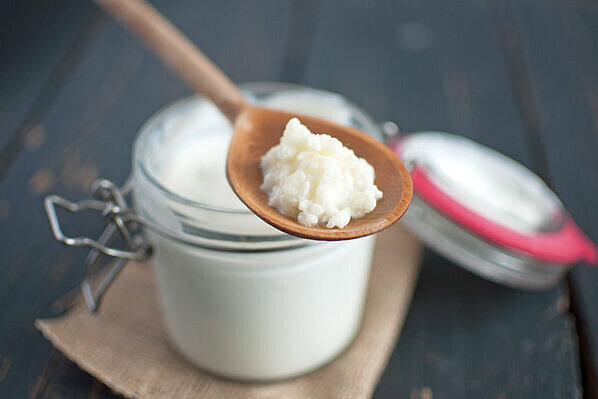Buttermilk

What is buttermilk?
Buttermilk is the liquid product that remains after cream has been skimmed during the butter-making process. Traditional buttermilk is rich in minerals and vitamins and is often prized for its probiotic properties. It is prized in many cultures for its digestive and health-promoting properties. However, while its benefits for humans are well documented, the situation for dogs is more complex.
Benefits of buttermilk for dogs
Natural probiotics
Buttermilk contains natural probiotics that can support gut health. These good bacteria can help stabilize gut flora, relieve digestive problems and boost the immune system. For dogs with sensitive stomachs or digestive problems, buttermilk could therefore be a useful supplement in moderation.
Calcium and minerals
Buttermilk is a good source of calcium, a mineral that is essential for bone health. Calcium not only helps build and maintain strong bones, but also plays a role in blood clotting and the transmission of nerve signals. In addition, buttermilk contains phosphorus and magnesium, which also fulfill important functions in the dog's body.
Hydration
Buttermilk, which is mostly water, can be a tasty way to increase your dog's fluid intake. This can be especially beneficial on hot days or for dogs that don't drink enough.
Disadvantages and considerations
Lactose intolerance
Many dogs are lactose intolerant, which means they cannot effectively digest milk sugar (lactose). Although buttermilk contains less lactose than whole milk, it can still contain enough to cause digestive discomfort such as bloating, diarrhea or vomiting in some dogs.
Calories and fat
Depending on how it is produced, buttermilk can have a higher fat content, which means extra calories. This could be a disadvantage for dogs that tend to be overweight or need a low-calorie diet.
Unknown allergens
Although allergies to buttermilk are rare in dogs, it is important to be cautious when introducing any new food. Allergic reactions can cause skin problems, digestive upset and other health issues.
Buttermilk can offer some benefits to dogs in small amounts and as an occasional treat, particularly due to its probiotic properties and essential mineral content. However, it is crucial to consider your dog's individual tolerance to lactose and only give buttermilk in moderation to avoid potential digestive problems.
Properties 8
Are you looking for other ingredients with a specific property?
Just click on them to find more.
If you notice any signs of hypersensitivity or poisoning in your dog, you should see your vet immediately. We are not a substitute for a vet, but we try to be as accurate as possible. Every dog reacts differently and we recommend you get a second opinion or consult your vet if in doubt.
Stay healthy and take good care of your four-legged friend!😊
Similar to Buttermilk
Yoghurt is a dairy product made by fermenting milk with certain bacterial cultures. This converts the lactose, i.e. the milk sugar, into lactic acid. This gives yogurt its typical taste and creamy...
Kefir is a sour milk drink that is made by adding so-called kefir grains to milk. The kefir grains are a mixture of various bacteria and yeasts that live in a gel-like matrix. The microorganisms...
Raita is a traditional Indian dish consisting mainly of yogurt enriched with various ingredients such as cucumber, carrots, herbs and spices. It serves as a side dish or dip and is known to soften...
Lassi is a yogurt-based drink that has its origins in India and is traditionally made from yogurt, water, spices and sometimes fruit. It can be found in two main varieties: sweet and savory. While...



